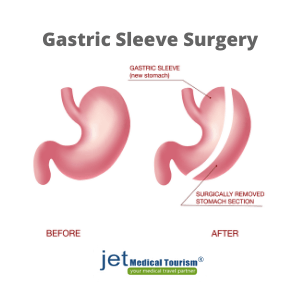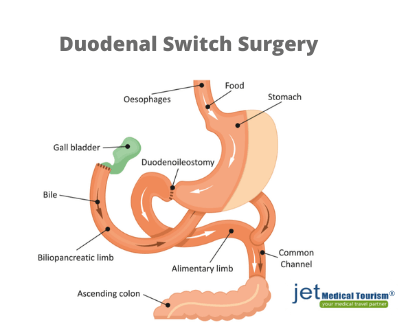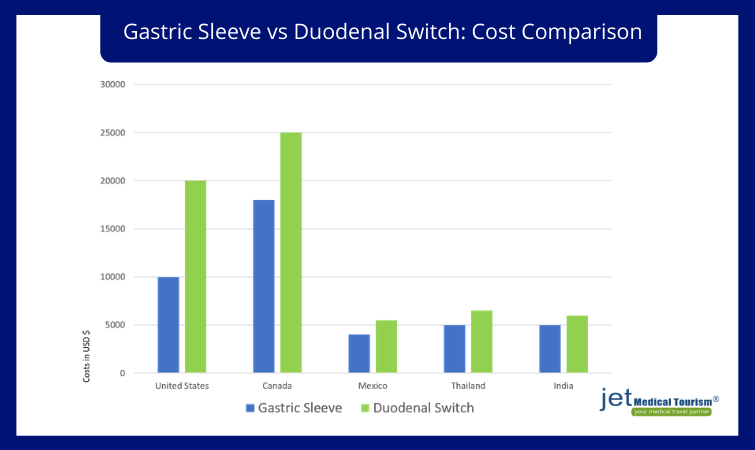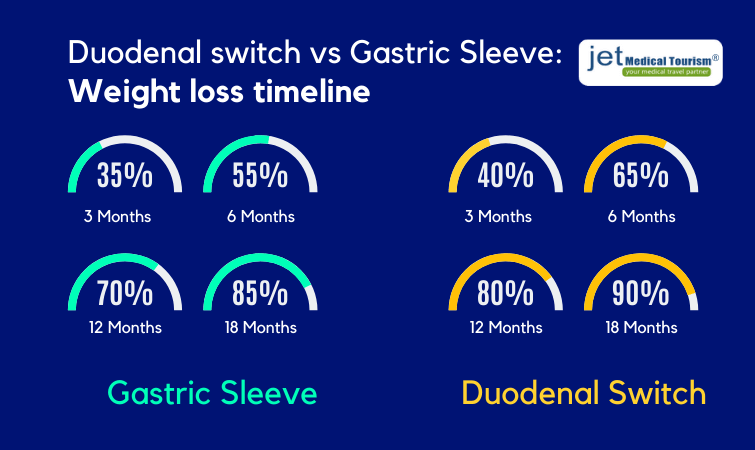Gastric Sleeve vs. Duodenal Switch

Gastric sleeve vs. duodenal switch comparison can help patients understand the pros and cons of each weight loss procedure and make an informed decision. Gastric sleeve surgery was originally created as the first stage of duodenal switch procedure. However, once bariatric surgeons and medical researchers realized its benefits, it gained acceptance as a standalone bariatric surgery.
Duodenal switch, clinically known as BPD/DS or biliopancreatic diversion with duodenal switch, is a more advanced bariatric surgery procedure to treat patients suffering from superobesity and severe co-morbidities. While more than 8 in 10 weight loss surgeries today are gastric sleeve, only a few duodenal switch surgeries are performed.
Before making a decision, patients should clearly know what is the difference between gastric sleeve and duodenal switch?
What is gastric sleeve or VSG surgery?

Procedure Overview
Gastric sleeve surgery is almost always performed laparoscopically, which involves the insertion of a tiny camera (laparoscope) through tiny incisions placed in the upper abdomen. Viewing the GI tract anatomy on a monitor, a bariatric surgeon will remove a large part of the stomach, and create a tubular pouch. The procedure is restrictive and helps curb appetite, enabling the patient to eat less and lose excess weight.
Benefits of Gastric Sleeve
- Average weight loss of up to 60 to 70% in one year
- Improvement or full resolution of obesity-related co-morbidities
- Low rate of complications during and post-surgery
- Minimal post-op downtime and discomfort, low scarring
- Highest safety profile among all major types of bariatric surgery
Related: Benefits of gastric sleeve surgery
What is duodenal switch surgery?

Procedure Overview
The first step in a duodenal switch procedure is VSG surgery, which involves removal of about 80% of your stomach volume. In the second step, your surgeon will bypass a large part of your small intestine, and connect its tail-end to the duodenum, which is located close to the stomach. BPD/DS or duodenal switch surgery is usually performed as a single procedure. The surgery may be performed laparoscopically or as a traditional open surgery.
Benefits of Duodenal Switch
- Rapid weight loss in the first six months
- Average weight loss of up to 80% in the first year
- Higher sustainability of weight loss for many years or a lifetime
- Improvement or remission of severe co-morbidities such as diabetes
- Dramatic improvement in quality of life for super-obese patients
What is the difference between gastric sleeve and duodenal switch?
To understand gastric sleeve vs. duodenal switch differences, you should know how each procedure works. Gastric sleeve surgery is the first choice of treatment for most patients having mild to moderate obesity. Duodenal switch surgery is recommended only in exceptional cases, where the surgeon determines that the patient’s goals may not be met with a less invasive bariatric procedure.
How gastric sleeve surgery works?
Gastric sleeve surgery is a restrictive procedure, which works in the following ways to help you lose excess weight:
- When the stomach size is reduced, it will restrict your capacity to eat food. You will tend to eat smaller meal portions, and will feel full faster after eating a small amount of food.
- Gastric sleeve surgery will reduce the secretion of ghrelin (the ‘hunger hormone’) in your body. This will naturally curb your appetite, and you will feel hungry less often through the day.
- Your stomach motility will increase after a vertical sleeve gastrectomy. This means that the food will pass faster through your pouch and intestine, which will support weight loss.
How duodenal switch surgery works?
Duodenal switch surgery is both restrictive and malabsorptive, which works in the following ways to help you get rid of super-obesity:
- As a restrictive procedure, duodenal switch will drastically limit the amount of food your stomach can accommodate at one time. You will naturally eat less and feel full faster.
- As a malabsorptive procedure, duodenal switch will reduce your calorie absorption in the small intestine. So, even when you eat a certain amount of food, its calorific effect will be lower.
- Duodenal switch procedure will alter your gut hormones, which will reduce your hunger, increase your satiety, and also help regulate your blood sugar. All these effects will help promote further weight loss.
Related: Gastric Bypass vs Duodenal Switch
Gastric sleeve vs duodenal switch: Eligibility requirements
One of the key differences between duodenal switch vs. gastric sleeve is the eligibility conditions for each procedure. Your bariatric surgeon will carefully evaluate your weight and health parameters before recommending the appropriate procedure. You cannot choose duodenal switch simply because you want to achieve massive weight loss, or choose gastric sleeve just because you want a less invasive option. Let your surgeon make this decision for you.
Eligibility for Gastric Sleeve
- Your body mass index (BMI) is 40 or higher
- Your BMI is 35 or higher and you suffer from co-morbidities
- You do not suffer from any medical conditions that can interfere with your surgery or recovery
- You are committed to maintaining post-op gastric sleeve diet and exercise as recommended by your surgeon
- You have been cleared by your surgeon to undergo general anesthesia
Eligibility for Duodenal Switch
- Your BMI is 50 or higher (which is the super-obesity category)
- You have severe obesity-related co-morbidities, such as type 2 diabetes
- You do not have serious contraindications, such as high cardiovascular risk or severe coagulopathies
- You have no eating disorder or severe psychiatric illness which could prevent you from following your post-op bariatric diet
- Your bariatric surgeon has cleared you for undergoing general anesthesia
Gastric sleeve versus duodenal switch: costs and insurance coverage
Cost and insurance coverage are key considerations when you are comparing gastric sleeve vs. duodenal switch surgery. In general, the duodenal switch procedure will cost more than gastric sleeve. Without insurance coverage, the cost of these procedures can be prohibitively high for many patients in the US or Canada.
However, you can choose the same procedure in Mexico at a small fraction of the cost in your home country. The following data shows the estimated average cost range for each procedure:
| Country | Gastric Sleeve | Duodenal Switch |
| United States | $10,000 to $25,000 | $20,000 to $35,000 |
| Canada | $18,000 to $27,000 | $25,000 to $35,000 |
| Mexico | $4,000 to $6,000 | $5,500 to $7,000 |
| Thailand | $5,000 to $7,000 | $6,500 to $8,000 |
| India | $5,000 to $6,500 | $6,000 to $7,500 |
Sleeve vs DS Surgery: Procedure duration
Many patients are concerned about how long is a duodenal switch surgery in comparison to a gastric sleeve. The duration of each procedure will vary according to your unique condition, but in general, a duodenal switch will take longer.
At the time of your pre-operative consultation, you should discuss with your surgeon how long does duodenal switch surgery take, and whether your health condition allows you to remain under general anesthesia throughout the length of the procedure.
- Pre-Op Preparation Time: When it comes to VSG vs. DS surgery, the pre-operative preparation time is not more than 30 minutes in each case. However, if you have multiple co-morbidities in case of DS surgery, longer pre-op time may be involved to test all your health parameters on the morning of the surgery.
- Anesthesia and Surgery Time: In case of gastric sleeve surgery, you can expect your procedure to be completed within 60 to 90 minutes in the operating room. However, the duodenal switch surgery may take two to three hours because this procedure involves two separate stages, which are performed at the same time.
- Overnight Hospital Stay: This can vary depending on your age, health, and other factors. In general, a gastric sleeve surgery may involve just one night’s stay at the hospital, or you may even return home the same day after surgery. In case of duodenal switch, you might require a hospital stay of two to three days, depending on your condition.
Duodenal switch vs sleeve surgery: Recovery
Recovery process will be slightly different between duodenal switch vs. vertical sleeve surgery. VSG is usually a less invasive procedure, involving no changes to your intestine. Therefore, the post-surgical recovery will be faster compared to a duodenal switch. However, the post-op dietary recommendations will usually be quite similar for both types of surgery.
Recovery after Vertical Sleeve
- Complete bed rest for up to 24 hours after surgery.
- Begin short walks and light activities after 24 hours.
- Stay home or at the hotel room for one week.
- Travel or return to your workplace after a week or 10 days.
- Resume your exercise and fitness routine after 4 to 6 weeks.
Related: Gastric Sleeve Recovery Guide
Recovery after Duodenal Switch
- Complete bed rest for up to 48 hours after the surgery.
- Begin short walks and light activities after 48 hours.
- Stay confined to your home or hotel room for 10 days.
- Travel or return to workplace after 10 to 14 days.
- Resume your exercise and fitness routine after 6 to 8 weeks.
Duodenal switch vs VSG surgery: Weight loss timeline
To understand what is the difference between gastric sleeve and duodenal switch, you should know the pace of weight loss in both cases. This will help you form realistic weight loss goals and you can stay inspired to continue your weight loss journey successfully.
Here is the estimated weight loss timeline for duodenal switch vs. VSG surgery. Please note these are average estimates, while individual results can vary.
VSG Surgery – Weight Loss Timeline
- Weight Loss at 3 months: 25% to 35% of your excess body weight
- Weight Loss at 6 months: 45% to 55% of your excess body weight
- Weight Loss at 12 months: 65% to 70% of your excess body weight
- Weight Loss at 18 to 24 months: 75% to 85% of your excess weight
Related: Gastric sleeve weight loss timeline
Duodenal Switch – Weight Loss Timeline
- Weight Loss at 3 months: 30% to 40% of your excess body weight
- Weight Loss at 6 months: 55% to 65% of your excess body weight
- Weight Loss at 12 months: 75% to 80% of your excess body weight
- Weight Loss at 18 to 24 months: 85% to 90% of your excess weight
Gastric sleeve surgery versus duodenal switch surgery: Success rate
Success rates of gastric sleeve vs. duodenal switch are marginally different because of the different levels of complexity in the two procedures. Gastric sleeve is a fairly straightforward bariatric surgery, which has limited goals of weight reduction. Duodenal switch procedure, on the other hand, is more advanced and performed on patients with more complex goals of eliminating super-obesity and severe co-morbidities.
Gastric Sleeve – Success Rate
One research study showed that patients on average experienced an excess weight loss of 60 to 82% at 12 months after gastric sleeve. Obesity-related diabetes and hypertension symptoms improved in more than 70% of the patients, while obstructive sleep apnea was resolved in all the patients who participated in the study.
Related: Gastric sleeve before and after pictures: Best photos (2021)
Duodenal Switch – Success Rate
One research study showed that 92% of the patients with a pre-surgery BMI of less than 50 were able to achieve a BMI of less than 35, while patients with a BMI of more than 50 were able to achieve a post-surgical BMI of less than 40 at one year. The success rate appears to be more dramatic in case of duodenal switch because of the more invasive surgery.
Gastric sleeve or duodenal switch: Which bariatric surgery is right for me?
The decision to choose between gastric sleeve versus duodenal switch surgery should be made in close consultation with your bariatric surgeon. In general, you should keep the following pros and cons in mind while evaluating your options between these two procedures.
- Invasiveness: Gastric sleeve is significantly less invasive than duodenal switch.
- Weight Loss Success: Duodenal switch surgery is likely to produce more dramatic weight loss results than gastric sleeve.
- Risks & Complications: Gastric sleeve surgery involves considerably lower risk and has a lower rate of complications than DS surgery.
- Cost of Surgery: Sleeve gastrectomy will typically cost lower than a duodenal switch surgery.
- Co-morbidities Remission: Duodenal switch is likely to resolve or improve co-morbidities more effectively than a VSG surgery.
The bottom line is that both gastric sleeve and duodenal switch surgeries have their own advantages and limitations. What is best for one patient may not necessarily be right for another patient. Your goal should be to work with a trusted and competent weight loss surgeon who will objectively determine your candidacy for VSG vs. DS surgery and help you achieve permanent freedom from obesity in a safe and affordable way.
Gastric sleeve or duodenal switch: Comparison infographic






